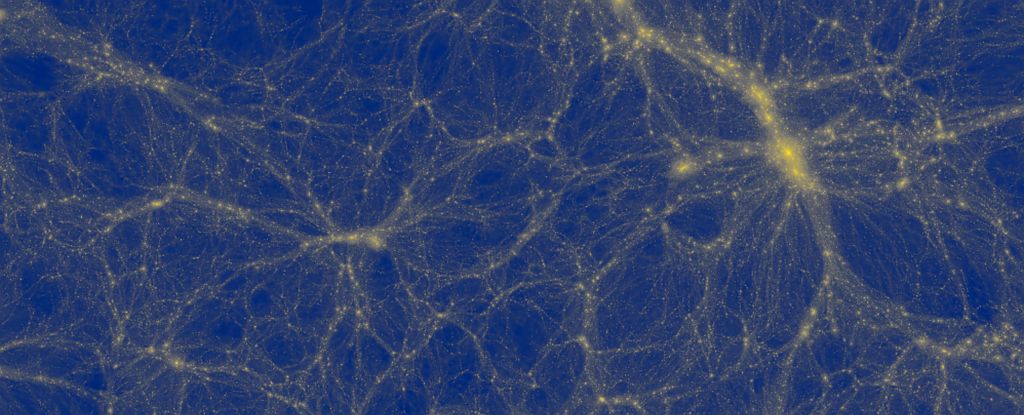How did we get here? Not just we humans, scrabbling about on a pale blue dot, hurtling around a star, hurtling around a supermassive black hole, hurtling through the local cluster. But how did the dot get here, and the star, and the black hole, and the cluster?
How did the incomprehensibly immense everything of it all get to where it is now, from an unimaginable nothing, billions of years ago?
That’s it, really, the question of questions. And, with the largest project of its kind to date, astronomers are attempting to find answers – by conducting computer simulations of the entire Universe.
They’re called the FLAMINGO simulations (Full-hydro Large-scale structure simulations with All-sky Mapping for the Interpretation of Next Generation Observations), run on a supercomputer at the DiRAC facility in the UK.
These simulations are intense. They’re designed to calculate the evolution of all the known components of the Universe.
That means normal matter: the stars; the galaxies; all the stuff we could touch (it might kill us, but we could); dark matter – the mysterious mass creating weird extra gravity; and dark energy – the mysterious power accelerating the expansion of the Universe.
The largest of these simulations has 300 billion particles with the mass of the small galaxy, in a cubic volume of space with edges of 10 billion light-years.
“To make this simulation possible, we developed a new code, SWIFT, which efficiently distributes the computational work over 30 thousand CPUs,” explains astronomer Matthieu Schaller of Leiden University.
The initial results have been published in three papers: the first describing the methods, the second presenting the simulations, and the third with results describing the large-scale structure of the Universe in cold dark matter.
In particular, the third paper sought to address something called the sigma 8, or S8 tension. This is based on a measurement of the Universe called the cosmic microwave background – the faint microwave radiation that fills the Universe from the epoch just after the Big Bang. Analysis of this light suggests that the Universe by now should have clumped together more than it has.
Since this tension presents a major challenge to the cold dark matter model of the Universe under which the clumping ought to happen, the researchers hope that FLAMINGO can provide some answers.
So far, they have not managed to resolve the tension – that would be huge news for cosmology – but they have something about conducting simulations: both normal matter and neutrinos are necessary for accurate predictions.
“Although the dark matter dominates gravity, the contribution of ordinary matter can no longer be neglected,” says research leader and astronomer Joop Schaye of Leiden University, “since that contribution could be similar to the deviations between the models and the observations.”
A simulation that includes normal matter is more difficult to run. Dark matter is only known to interact with the Universe gravitationally; normal matter also interacts with pressure, such as radiation pressure, and galactic winds, which are unpredictable and difficult to model. It requires quite a lot more computing power to make it work, so we’re going to have to wait a bit longer for answers on the S8 tension from FLAMINGO.
However, the researchers have conducted a series of simulations that track the formation of the structure of the Universe across dark matter, normal matter, and neutrinos, varying the parameters of all three to see how this affects the end result.
“The effect of galactic winds was calibrated using machine learning, by comparing the predictions of lots of different simulations of relatively small volumes with the observed masses of galaxies and the distribution of gas in clusters of galaxies,” explains astronomer Roi Kugel of Leiden University.
The team has not yet made its FLAMINGO data available to the public, because it is several petabytes in size. Anyone who is interested is encouraged to lodge a polite enquiry with the corresponding author.
The research has been published in the Monthly Notices of the Royal Astronomical Society. The three papers can be found here, here, and here.

Dr. Thomas Hughes is a UK-based scientist and science communicator who makes complex topics accessible to readers. His articles explore breakthroughs in various scientific disciplines, from space exploration to cutting-edge research.








